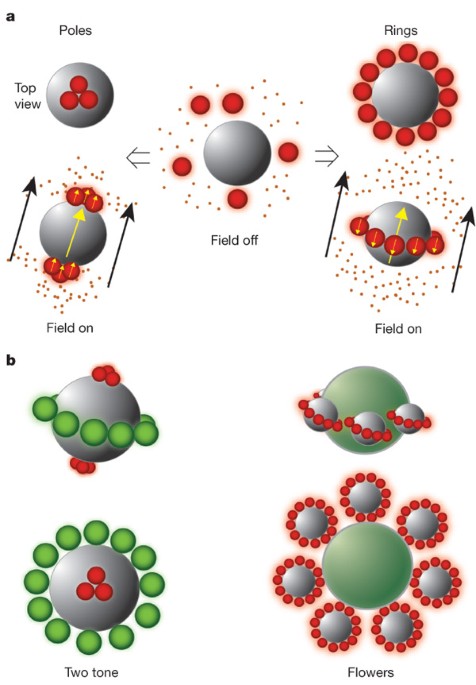
Magnetic assembly of colloidal superstructures with multipole symmetry
- Select a language for the TTS:
- UK English Female
- UK English Male
- US English Female
- US English Male
- Australian Female
- Australian Male
- Language selected: (auto detect) - EN
Play all audios:

The assembly of complex structures out of simple colloidal building blocks is of practical interest for building materials with unique optical properties (for example photonic crystals1 and
DNA biosensors2) and is of fundamental importance in improving our understanding of self-assembly processes occurring on molecular to macroscopic length scales3,4,5. Here we demonstrate a
self-assembly principle that is capable of organizing a diverse set of colloidal particles into highly reproducible, rotationally symmetric arrangements. The structures are assembled using
the magnetostatic interaction between effectively diamagnetic and paramagnetic particles within a magnetized ferrofluid. The resulting multipolar geometries resemble electrostatic charge
configurations such as axial quadrupoles (‘Saturn rings’), axial octupoles (‘flowers’), linear quadrupoles (poles) and mixed multipole arrangements (‘two tone’), which represent just a few
examples of the type of structure that can be built using this technique.
The authors would like to thank the US National Science Foundation (grants NSEC DMI-0531171 and MRSEC DMR-0213695 to V.M.R. and grants CMMI-0608819 and CMMI-0625480 to B.B.Y.) for supporting
this work.
Randall M. Erb and Hui S. Son: These authors contributed equally to this work.
Department of Mechanical Engineering and Materials Science, Duke University, Center for Biologically Inspired Materials and Material Systems, Box 90300, Hudson Hall, Durham, North Carolina
27708, USA,
Department of Chemistry, University of Massachusetts, Amherst, Massachusetts 01003, USA,
This file contain Supplementary Materials and Methods, Supplementary Figures 1-3 with Legends and Supplementary Video Legends 1-5. (PDF 503 kb)
This file shows the synchronous rotation of Saturn particles in a rotating external field (see files s1 for full legend). (MOV 866 kb)
This file shows the formation and dissolution of Saturn particles (see file s1 for full legend). (MOV 4013 kb)
This file shows a tri-component aqueous suspension of colloidal particles (see file s1 for full legend). (MOV 453 kb)
This file shows the formation of mixed pole/ring structures (see file s1 for full legend). (MOV 1988 kb)
This file shows flower shaped colloidal particles (see file s1 for full legend). (MOV 2813 kb)
Anyone you share the following link with will be able to read this content:
Sorry, a shareable link is not currently available for this article.
The controlled assembly of complex structures from simple colloidal building blocks can produce materials with properties useful in photonics, as biological sensors and elsewhere. A new
method of assembling complex colloidal structures in bulk fluid by applying a magnetic field to a mixture of colloidal particles of different size, magnetization and composition is now
reported. The shapes that can be obtained when these particles are suspended in a ferromagnetic fluid resemble electric charge distributions such as quadrupoles and octupoles, generating a
variety of complex structures including ring- and flower-shaped assemblies. The repulsion that exists between two assembled particles also prevents the formation of clusters.
